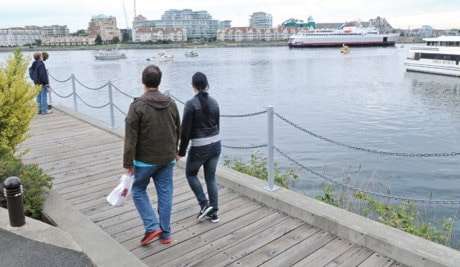The message was loud and clear.
Victorians love their harbour and want it formally protected B��Ԫ������ַ� whether for use by residents or industry B��Ԫ������ַ� in the city's new .
In response to the last round of feedback, planning staff heard that message and amended the document to place more emphasis on the harbour. Apparently, the changes didn't go far enough.
Many of those who spoke at the June 27 public hearing emphasized the need to protect and plan for the harbour's future.
The Official Community Plan needs to reinforce the water-land connection, said Curtis Grad, CEO of the Greater Victoria Harbour Authority. "Once severed, the link is gone forever."
The Inner Harbour should belong to residents of Victoria, not private interests, said Marg Gardiner, a director of the James Bay Neighbourhood Association. Others argued for the need to protect the working harbour, such as the aggregate businesses on Rock Bay.
"We need them," argued Ron Greene, who owns property on Store Street. Otherwise, aggregate will need to be shipped from Duke Point, he added.
The concerns voiced come in the wake of news that all three levels of government are selling, or potentially selling large tracts of waterfront land around the harbour.
In February, the announced its intention to sell its surplus property, which could include its portion of a waterfront parking lot below Wharf Street. Last month, the federal government announced it is selling many parcels of land, mostly running along the Upper Harbour.
At the same time, the city is considering the sale of waterfront industrial property in Vic West at Point Hope to Ralmax Group of Companies.
About 60 people attended the hearing.
Mike Miller of Abstract Developments led the presentations with a request for a more business-friendly city.
"The vacancy rate in downtown is alarming," said Miller, also chair of the Urban Development Institute's Victoria chapter.
He called for more emphasis on an economic action plan for the downtown and requested specific amendments: that the permit process be shortened, and parking requirements for new developments be lowered to reflect the fact many downtown residents don't own cars.
Many neighbourhood representatives also voiced their concerns.
Tracy James of Burnside-Gorge asked that traffic be slowed on some of the six arterials that pass through her neighbourhood, to help create a more walkable, cohesive community.
Bernie Gaudet of Vic West asked that his neighbourhood be moved up the priority list as the city moves forward with local area plans, targeting areas of change and growth.
"Vic West is severely splintered," he said. The neighbourhood is targeted to accommodate a large portion of the city's growth, yet new development is cut off from the older, established residential neighbourhood, he said.
Other people praised the extensive planning and consultation process that contributed to the draft plan.
"I'm really, really pleased to see an OCP deal with words like arts and culture," said Jason Scott, an architectural historian who lives in Fan Tan Alley. He asked, however, that no more heritage redevelopments be granted additional storeys. "What you're doing is wrong," he said.
Council ultimately voted to postpone deliberations until they could review a copy of the minutes. Only when the public hearing resumes, at an undetermined date in July, will councillors be allowed to comment publicly on the OCP or the hearing. Doing so could invalidate the process, requiring that a new public hearing be scheduled.
B.C. Transit seeks less-ambitious bus-stop vision
Victoria's draft Official Community Plan aims to have 99 per cent of residents living within 400 metres of a bus stop within the next 30 years.
B.C. Transit doesn't support the goal, however.
"This target may require transit to operate on local roads that are not intended to be served by transit," wrote B.C. Transit senior planner James Wadsworth, in a letter responding to the city's draft document. "Perhaps 90 per cent might be a better target."
The suggested amendment might be a little under ambitious; the city has already surpassed it.
rholmen@vicnews.com



